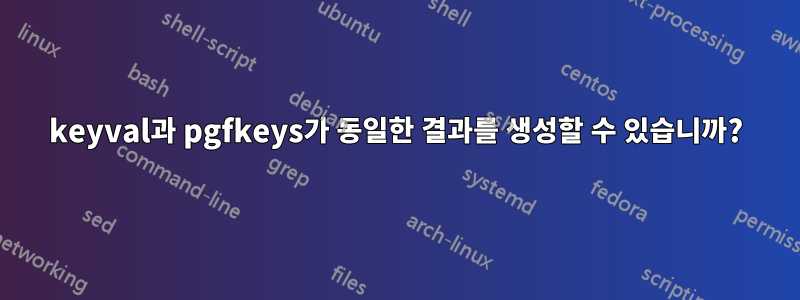
나는 약 5시간(!) 공부했어요키 값을 사용하여 명령을 만드는 방법은 무엇입니까?(및 기타 리소스) 키 값을 구현하는 방법을 이해하려고 노력했지만 매우 혼란스러웠습니다. 나는 본질적으로 사소한(여기 있는 대부분의 사람들에게는) 테스트 케이스를 작성했는데 설명할 수 없는 몇 가지 불일치가 있습니다.
다음은 keyval.
% !TEX TS-program = lualatexmk
% !TEX encoding = UTF-8 Unicode
\documentclass{article}
\usepackage{keyval}
\makeatletter
% Key definitions
\define@key{sayhello}{towhom}{\def\sh@towhom{#1}}
% Key defaults
\setkeys{sayhello}{towhom=Michael}
% Define the command that uses the key
\newcommand{\sayhello}[2][]{%
%\begingroup% localizes the new settings w/o calling the defaults
\setkeys{sayhello}{towhom=Michael} % Reset defaults w/o localizing
\setkeys{sayhello}{#1} % Set new keys
Say hello to \sh@towhom\ #2.
%\endgroup%
}%
\makeatother
\begin{document}
\sayhello{tomorrow}
%\sayhello[towhom]{today} % throws no value specified for towhom
\sayhello[towhom=Jill]{tomorrow}
%\sayhello[towhom]{today} % throws no value specified for towhom
\sayhello[towhom=Joe]{tomorrow}
%\sayhello[towhom]{tomorrow} % throws no value specified for towhom
\sayhello{today}
\end{document}
그리고 여기에 pgfkeys.
% !TEX TS-program = lualatexmk
% !TEX encoding = UTF-8 Unicode
\documentclass{article}
\usepackage{pgfkeys}
\pgfkeys{%
/sayhello/.is family, /sayhello,
towhom/.default=Michael,
towhom/.store in=\sayto
}%
\newcommand*{\sayhello}[2][]{%
\pgfkeys{/sayhello,#1}
Say hello to \sayto\ #2.
}%
\begin{document}
%\sayhello{tomorrow} % throws undefined control sequence
\sayhello[towhom]{today}
\sayhello[towhom=Jill]{tomorrow}
\sayhello[towhom]{today}
\sayhello[towhom=Joe]{tomorrow}
\sayhello[towhom]{tomorrow}
\sayhello{today} % works perfectly
\end{document}
나는 두 구현 모두 동일한 결과를 제공하기를 바랐습니다. 그들은하지 않습니다. keyval값 없이 키를 지정하는 것을 좋아하지 않는 것 같습니다. pgfkeys옵션이 전혀 제공되지 않으면 일관되지 않게 동작하지만 keyval그렇지 않은 경우에는 완벽하게 동작합니다. 내 예제가 잘못 코딩되었나요? 불일치가 예상되는 동작입니까? 나는 완전히 혼란스러워요.
답변1
초기값과 기본값을 혼동하고 있습니다. 두 번째는 값을 제공하지 않고 키를 사용하는 경우에 사용됩니다. 이 외에도 명령을 사용하여 키 값을 저장하는 경우 먼저 로 정의하는 것이 좋습니다 \newcommand. 이렇게 하면 기존 명령을 덮어쓰는 것을 방지할 수 있습니다.
pgfkeys개인적 으로 키를 정의하고 설정하는 동일한 명령이 사용되며 일부 핸들러의 동작을 이해하는 것이 항상 쉬운 것은 아니기 때문에 더 혼란스럽다고 생각합니다. 예를 참조하세요.pgfkeys 키 처리기 .get 및 .store는 무엇을 수행합니까?.
\documentclass{article}
\usepackage{keyval}
\makeatletter
\newcommand\sh@towhom{}
\define@key{sayhello}{towhom}[Default]{\def\sh@towhom{#1}}
\setkeys{sayhello}{towhom=Initial}
\newcommand{\sayhello}[2][]{%
\begingroup
\setkeys{sayhello}{#1} % Set new keys
keyval, say hello to \sh@towhom\ #2.
\endgroup%
}%
\makeatother
\usepackage{pgfkeys}
\newcommand\sayto{}
\pgfkeys{%
/sayhello/.is family, /sayhello,
towhom/.store in=\sayto,
towhom/.default=Default,
towhom = Initial,
}%
\newcommand*{\sayhellopgf}[2][]{%
\begingroup
\pgfkeys{/sayhello,#1}%
pgfkeys, say hello to \sayto\ #2.
\endgroup
}%
\ExplSyntaxOn
\tl_new:N \l_sayhello_towhom_tl
\keys_define:nn {sayhello}
{
towhom .tl_set:N = \l_sayhello_towhom_tl,
towhom .initial:n = Initial,
towhom .default:n = Default
}
\NewDocumentCommand\sayhelloexpl{O{}m}
{
\group_begin:
\keys_set:nn{sayhello}{#1}
l3keys,~say~hello~to~\l_sayhello_towhom_tl\c_space_tl#2
\group_end:
}
\ExplSyntaxOff
\begin{document}
\sayhello{tomorrow}
\sayhello[towhom]{today}
\sayhello[towhom=Jill]{tomorrow}
\sayhello[towhom]{today}
\sayhello[towhom=Joe]{tomorrow}
\sayhello[towhom]{tomorrow}
\sayhello{today}
\sayhellopgf{tomorrow}
\sayhellopgf[towhom]{today}
\sayhellopgf[towhom=Jill]{tomorrow}
\sayhellopgf[towhom]{today}
\sayhellopgf[towhom=Joe]{tomorrow}
\sayhellopgf[towhom]{tomorrow}
\sayhellopgf{today}
\sayhelloexpl{tomorrow}
\sayhelloexpl[towhom]{today}
\sayhelloexpl[towhom=Jill]{tomorrow}
\sayhelloexpl[towhom]{today}
\sayhelloexpl[towhom=Joe]{tomorrow}
\sayhelloexpl[towhom]{tomorrow}
\sayhelloexpl{today}
\end{document}



